The Aftermath….
Yesterday evening, I started to see the signs….
Gusty winds, thunder clouds, the smell of rain in the air and raindrops starting to fall. A monsoon storm was on it’s way.
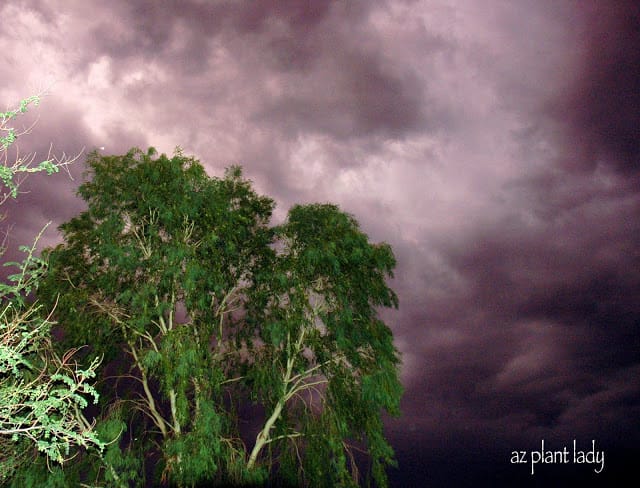
Monsoon storm, Clouds gathering over my house and Eucalyptus tree.
When I first moved to the desert southwest from California, I was quite surprised that it rained in the desert frequently in the summer months. Where I came from, summer rain was quite rare.
Another surprise awaited me when I experienced my first monsoon storm….flying dust followed by high winds, thunderclouds, lightning and torrential downpours – these were definitely things that I had not experienced in California.
*The Sonoran Desert has two rainy seasons, one in the winter and one in the summer. Because of this our desert has the most animal and plant species of any North American desert. We have over 2,000 native plant species alone.
Although I love monsoon storms, I would dread going to work the day afterward because I knew that there could be a lot of tree damage to deal with due to the high winds…especially on the golf courses. I would have to personally check all of the trees…some were completely blown over with roots sticking out and my crew would quickly cut them up. Other trees would half in and half out of the soil and I would have to decide if we could save them or not.
One summer brought a severe micro-burst over the area where I worked and the damage to the trees on the golf courses were thankfully, minimal, except for a large Saguaro cactus that was lost and just a handful of trees.
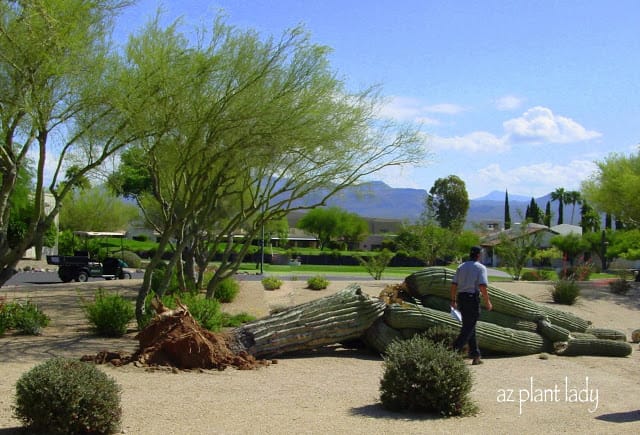
However, it was the damaged trees that I saw as a result of the storm in the residential areas that was shocking.
There were the trees that had been completely blown over…
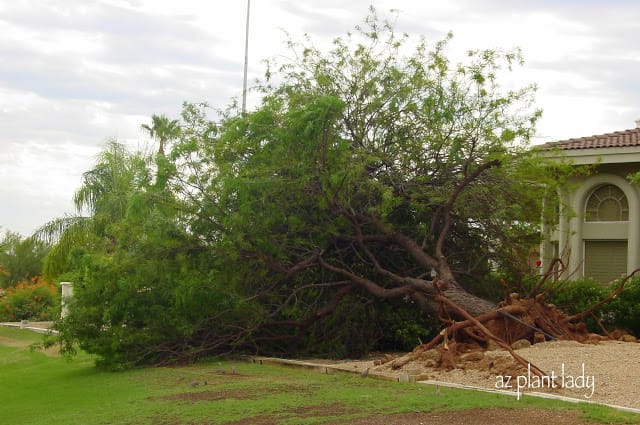
Fallen Mesquite
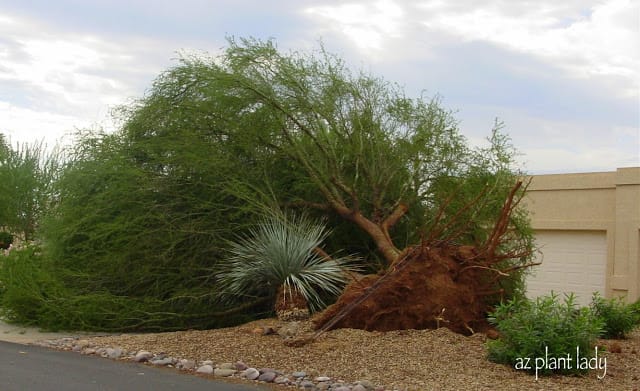
Fallen Palo Verde
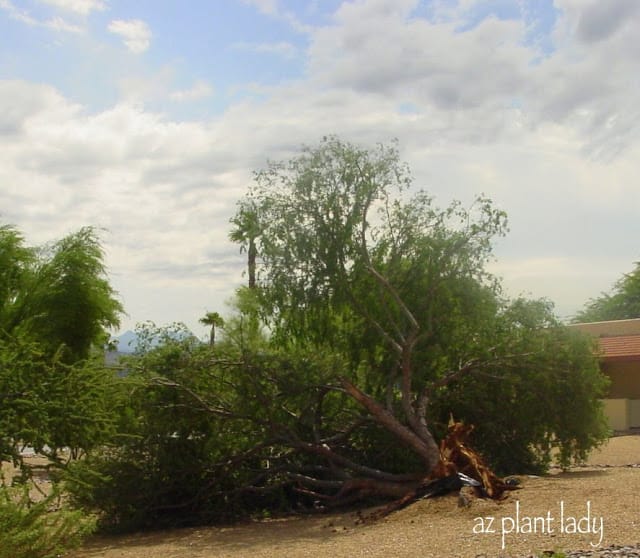
Fallen Ironwood
Some trees were completely snapped off at their base….
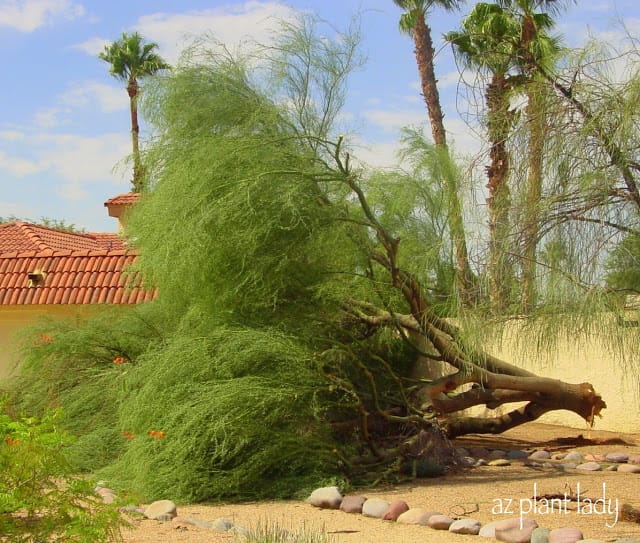
Palo Verde
Some trees that completely lost their head…literally.
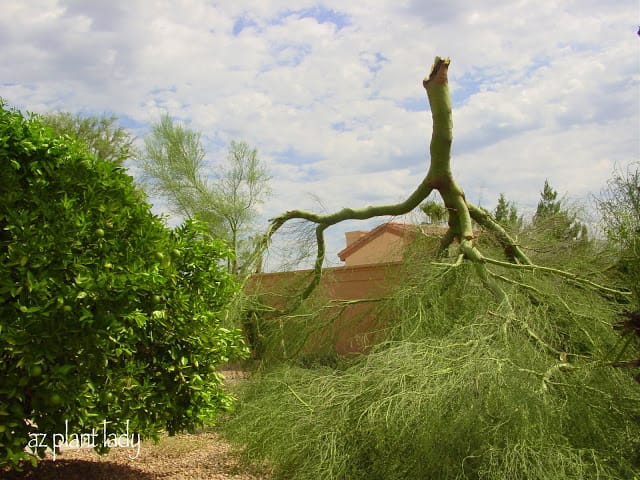
This Palo Verde snapped off halfway up the trunk.
Some trees looked like they were swallowing up homes….
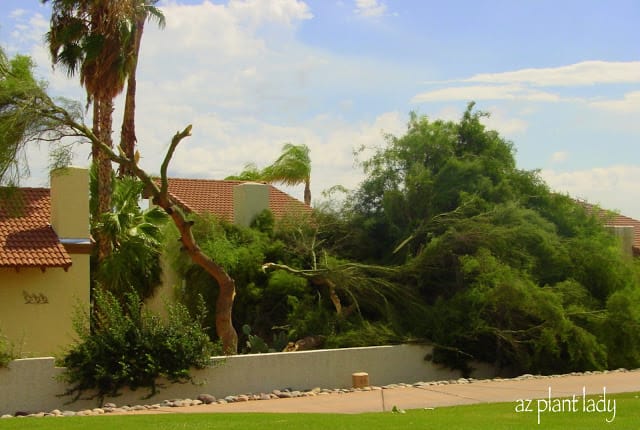
Although we did suffer some losses on the golf courses and landscape areas, the homeowners were hit the hardest in regards to damaged trees – mostly because their trees were either somewhat top-heavy or had not been pruned recently, or pruned correctly.
You may be asking, what can I do to avoid having this happen to my tree? Well, there are some steps that you can take to help prevent wind damage, BUT even if you maintain your trees correctly, wind damage may be unavoidable. Following these tips will increase your chances of escaping severe wind damage, but nothing can totally prevent it due to circumstances beyond your control.
First, you may notice that all the trees in the pictures had a single (standard) trunk. Imagine holding a lollipop at the base of the stick. The top of the lollipop is quite heavy, isn’t it? Well, this is the same for many single trunk trees. Many desert trees such as Mesquite, Palo Verde, Sweet Acacia and Ironwood are available in both standard (single) or multi-trunk forms. In my opinion, multi-trunk trees are more attractive in addition to the fact that they are less likely to suffer damage from wind because the weight of the branches is more evenly distributed among multiple tree trunks.
Second, proper pruning will help your trees to weather the storms. I would always schedule our annual tree pruning to be done before the monsoon season would begin. The International Society of Arboriculture has excellent information on how to prune mature trees which can be found here. Trees add lots of value to your house – not just aesthetically, but in dollars as well. So, it is worth the investment to hire a Certified Arborist to advise you on the correct way to prune your trees. Most also offer pruning services for your trees as well. *You can find a Certified Arborist in your area by following this link.
Last, make sure that your trees are watered correctly. Trees need to be watered deeply, so that their roots will grow down into the soil. Repeated shallow watering results in tree roots that are close to the surface and are not able to anchor a tree against high winds.

As I write this, I see storm clouds gathering to the east. I am hoping for a nice rainstorm tonight, without the high winds 😉

 Noelle Johnson, aka, 'AZ Plant Lady' is a author, horticulturist, and landscape consultant who helps people learn how to create, grow, and maintain beautiful desert gardens that thrive in a hot, dry climate. She does this through her consulting services, her online class Desert Gardening 101, and her monthly membership club, Through the Garden Gate. As she likes to tell desert-dwellers, "Gardening in the desert isn't hard, but it is different."
Noelle Johnson, aka, 'AZ Plant Lady' is a author, horticulturist, and landscape consultant who helps people learn how to create, grow, and maintain beautiful desert gardens that thrive in a hot, dry climate. She does this through her consulting services, her online class Desert Gardening 101, and her monthly membership club, Through the Garden Gate. As she likes to tell desert-dwellers, "Gardening in the desert isn't hard, but it is different."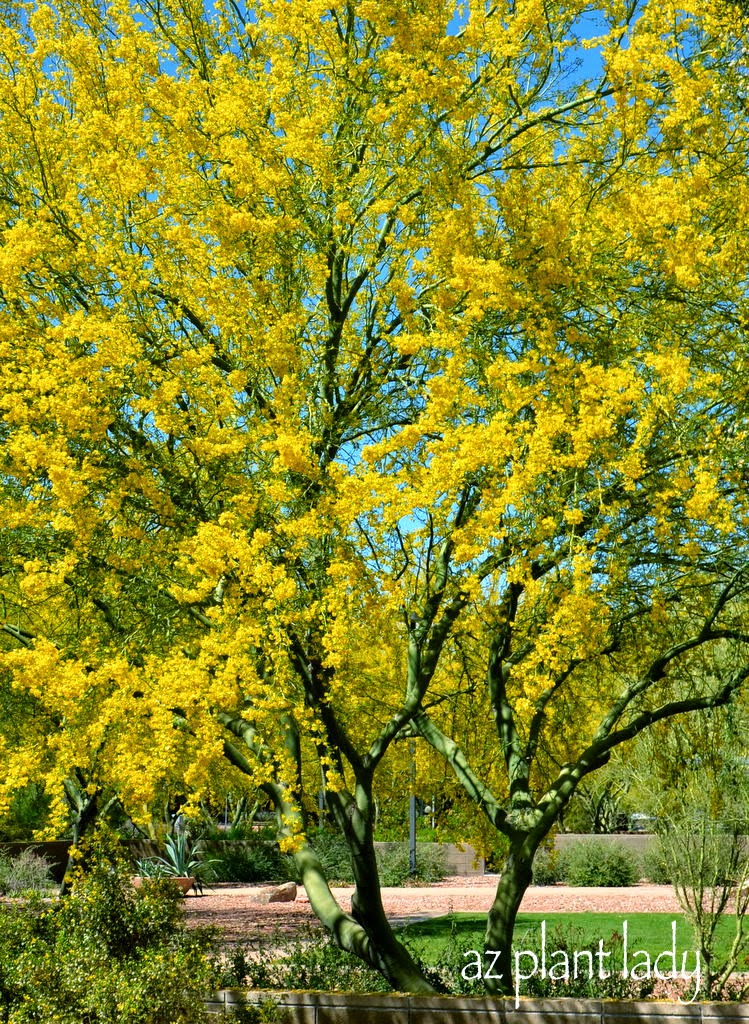
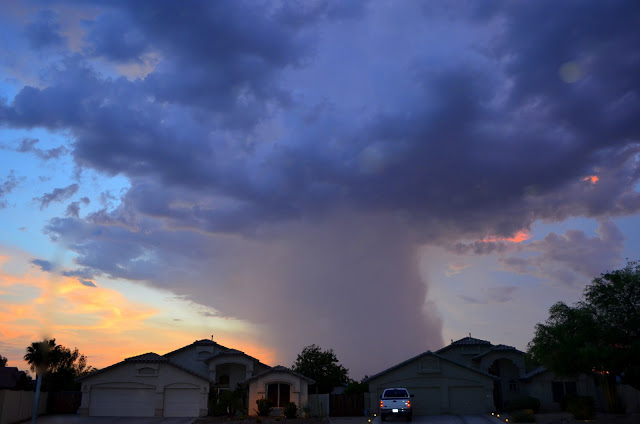


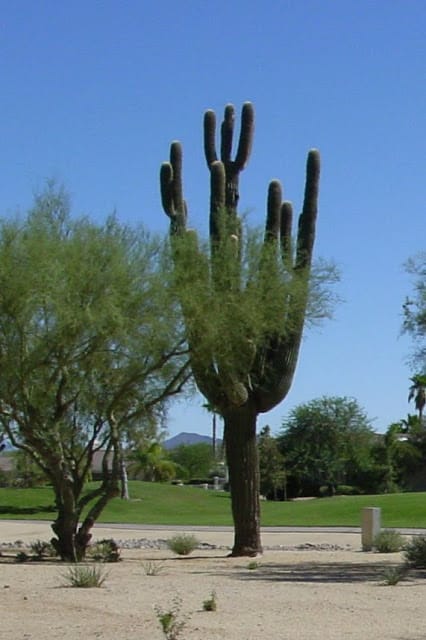









Dear Noelle, What dramatic pictures you show here. I am very sorry for those people who have lost mature trees. They leave such a big gap in any garden and take many years to replace. Your advice is very comprehensive and I often say to people to water a lot or not at all. Shallow watering is very damaging for most plants in my view.
Noel,What do you mean by heading cuts versus thining cuts? Perhaps you could explain. Most people think heading cuts is to just cut the top off the tree, not a good pratice.
This year I am having to water my trees. Most years, they do just fine. But this year the lack of rain is so bad, that even my drought-tolerant trees are suffering. My southern magnolia had lost most of its leaves (usually there is a lot of leaf loss with these trees, but this year they were all practically bald in my neighbourhood). I try to water my trees very thoroughly, since I do have to water them. I hate to see a mature tree get destroyed like that. 🙁
Will that saguaro bud from the broken pieces?
Wow! What dramatic images!
Wow! Those are some scary looking desert skies! Those after-photos look like one of our hurricanes just went through. Though there's nothing like the sight of an uprooted 200-year-old oak (i.e., sitting in the ground-level foyer of my two-story house). I'm always amazed by the old trees that are spared nature's wrath. She strikes hit and miss.
Great pictures Noelle. I really feel sorry for the homeowners to have lost those trees.
It sounds like you get some big storms there. What is a micro-burst?
Hope you have gentle rains.
FlowerLady
Oh, those poor trees! The cactus really sadden me, sigh. We get pop-up storms here in the summer and we welcome the rain but not the damage from the winds. We lost one tree to lighten recently but two days ago, a lot of people around us lost trees with that storm. One tree went over a power line and we lost power for about 30 minutes until the crews could remove the tree and then the eclectic dept could make repairs. What a mess on the roads with twigs, limbs, etc. We take the Bad with the Good, Rain being good…
Your pictures brought back memories of Hurricanes Fran and Floyd when we lost many large willow oaks in my neighborhood and tall pines in other parts of town. The pines sliced right through houses in some places. The oaks would fall slowly and seemed to sink into the houses rather than hitting them like a blade. Many people had most of the trees around their houses removed after that – a sad thing. I'm willing to take my chances.
Hello,
I actually amended this post to better explain the best way to prune mature trees….thank you Cindy for pointing that out to me 🙂
Susan,
Sadly no, we were not able to plant the individual pieces of the saguaro. The decision was made (not by me) not to do this. The problem was that the arms were so large, it would have been difficult to stake them up once transplanted. But, it is possible to root a saguaro arm.
WOW, thanks for sharing this story! I love your first photo. The color of the sky is amazing!
I've lost some trees to high winds but not ones I myself have planted. In the rocky soil here I have found it necessary to dig deep and wide so that the roots will have somewhere to go. The developer failed to do that and the trees suffered.
Goodness, what angry looking skies. Rain in summer here, as you know, would be practically front page news. The sight of that poor Saguaro toppled over is very sad. We've been trying to restore health to a number of mature trees near the house that were previously neglected. We're all too aware of the damage to property, and heaven forbid life, a sickly mature tree can cause during a storm, especially if it falls on a structure. It's so important not to plant them and ignore them.
Incredible sky pictures, so ominous looking!! I'm always saddened by fallen trees after a storm, and although some damage is inevitable you're absolutely right that proper maintenance can go a long way.
That must have been a nasty wind! We get canyons winds mostly in the Spring and Fall… and they can be quite nasty, too.
I really feel pity for that cactus tree, it look shattered like a melon! Though the damage around the resident area also look serious. Its going to take a lot of cleaning and clearing to do before the next storm hits.
What fabulous storm photos!
Great post, more vivid with your photos. Having lived in a hurricane zone, I can second your comments. Nothing will stop a Cat 3 but proper pruning may let the wind whistle through the branches instead of blowing the tree down.
Wow, amazing images Noelle. In Colorado, it's always a good thing when the monsoon flow begins ~ that means we get much needed summer moisture and relief from the heat. I never thought about how damaging it could be. Most of our wind is during other seasons although it has been windy this summer. I'm assuming the rains cool you off too?? Sorry they have to be such severe storms.
All your advice (on how to avoid tree loss) sounds very prudent to me.
Oh thank you for sharing those photos! We haven't had those monsoon rains for several years now here in Vegas. I remember a few years back that it would cloud up in the afternoon and rain. For whatever reason we just aren't getting any of the moisture, and I miss that! Oh how I long for a little desert rain!
Those storm clouds look so intense, glowering there in the sky. Great shots, especially the one of the clouds gathering over the eucalyptus.
This is great advice and information, Noelle, as always! Having gone through the heartbreak of losing a mature tree that meant a lot to me, I'd like to avoid that as much as possible when (if?) F. and I ever have our own house and property. Now that you mention it, when my parents' magnolia grandiflora fell, a nearby silver maple, about the same size, wasn't even slightly disturbed — and it has many trunks. And here in the woods, it always seems to be the tall, single-trunked pines that fall in the storms. So there you go, perfect illustrations of your point. 🙂
It is stunning what wind can do … what awesome photos. That dark sky looks pretty menacing!
I hope you came through the storm OK! Your photos are stunning! I had no idea the desert had storms like that. The tree damage reminds me of some of the damage we sometimes see with our bad storms. You make good points about pruning and multiple trunk trees. Thanks for a great post!
aloha noelle,
wow, what a scary thing to go through, you never think this happens in the dessert..whole trees snapping or tearing apart at the roots…very good suggestions on keepiing them trimmed to ensure their safety and yours.
I love that first pic…incredible. Tonight looks to be a good one tonight in the Old Pueblo:)
Noelle,
I live in the desert near Palm Springs, Mojave as opposed to your sonoran, funny similar, yet not 🙂
I love your photos.
Can you give some advice on watering?
We have a big Palo Verde in front. House is only 4 yrs old, we bought it last year and the tree's already over the height of the house. I will find someone to properly trim it this fall.
Our bubblers are set for a couple times a day, I believe 15 minutes ea. How do I know if this is the correct amount for deep watering so the roots grow deep and not shallow?
Thank you.
wow Noelle those are dramatic sky photos.
Wow, there were some serious damages.